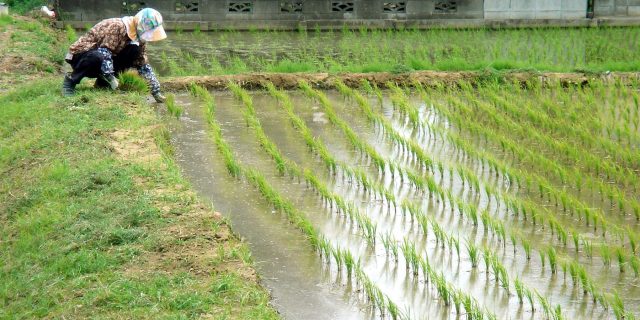28
Sep
“Weedy Rice” Develops Herbicide Resistance: Agrichemical Industry Repeating Mistakes?

(Beyond Pesticides, September 28, 2022) ‘Weedy rice,’ a close relative of cultivated rice that invades rice fields and reduces yields, is rapidly developing herbicide resistance in critical rice growing areas throughout the United States. According to research published this month in Communications Biology, the widespread planting of herbicide-resistant rice, developed through traditional, transitional (non-genetically engineered) breeding techniques, is driving this concerning phenomenon. The findings highlight the risk to agricultural production that relies on crops developed to tolerate repeated applications of synthetic chemicals, regardless of their method of development.
Weedy rice is a form of rice that was “re-wilded,” or “de-domesticated” from cultivated rice, independently evolving multiple times throughout the world. It is highly adapted to grow in areas where cultivated rice is produced, and can result in significant yield loses, as well as a reduction in quality that reduces marketability.
In the early 2000s, the agrichemical industry believed they had found a solution to the weedy rice. Multinational chemical corporation BASF developed a line of rice cultivars, produced through traditional breeding, that conferred resistance to imidazolinone class herbicides. This includes chemicals like imazapyr, imazaquin, imazethapyr, and imazamox, which poses cancer, reproductive, and neurotoxic risks to human health, and is toxic to bees and aquatic organisms. This line of rice, dubbed “ClearfieldTM rice,” now represents more than on third of all rice production in the U.S.
Farmers began noticing hybridization of weedy rice, and subsequent herbicide resistance soon after the herbicide resistant cultivars were introduced, and by 2010 one study found 80% of weedy rice to be resistant.
With weedy rice causing an estimated $45 million annually in losses, scientists set out to better understand the current state of affairs. In 2018, weedy rice was sampled across five Arkansas rice fields, and its genome was sequenced. Researchers found that nearly all weedy rice is a crop-weed hybrid, yet its genomes shifted to become much more similar to its characteristically weedy forebears.
“The situation is somewhat analogous to human health and the emergence of antibiotic-resistant bacterial pathogens. Widespread use of antibiotics ends up strongly selecting for the rapid evolution of the drug-resistant strains,” said senior study author Kenneth Olsen, PhD, of Washington University St Louis. “With weedy rice, herbicide-resistant weeds were being detected just a couple of years after herbicide-resistant rice was first commercialized.”
This cross-breeding can occur when herbicide sprays do not kill all the weedy rice plants, and they happen to flower concurrent to the cultivated, herbicide-resistant rice crop. “As a de-domesticated weedy relative, weedy rice has always been able to outcross with cultivated rice. Based on our results, this ability to interbreed is what led to most of the herbicide resistance that we see today,” study coauthor Marshall Wedger, PhD said.
Researchers note that the problem farmers are encountering is a result of an agricultural approach that relies on a single, streamlined method of weed control. “Just like in the case of antibiotic resistance, the rise of resistance to this particular herbicide will be met with a new technology that relies on a new herbicide,” Wedger said. “New herbicide-resistant cultivars are already in development, so I expect this process to repeat.”
While the scientific community studies this process, it is not enough for pesticide reform advocates to simply throw their hands in the air as the next version of this overly simplified agricultural practice is perpetuated. The story here is a perfect example of what many opponents of genetic engineering have espoused – although genetic engineering is a risky technology that should be highly regulated, it is the agronomic practices genetic changes propagate that are most concerning. In other words, it is not the fact that crop has been genetically engineered that is the primary issue, but the fact that its use supports a toxic system that increases reliance on highly hazardous pesticides as a regular course of crop production. Whether created from traditional or genetic engineering, such a system is inherently flawed and sisyphean, kicking the can of responsible management down the road for future farmers.
Yet as the chemical industry scrambles to create a new crop or chemical, traditional, effective management techniques are slowly lost. A recent study found that traditional, diversified rice production that integrated animals into the system was able to significantly outperform yields seen in the sort of monoculture rice fields that are reliant on toxic pesticides. And as new chemical solutions are developed with high cost to the environment and society, it becomes increasingly difficult for farmers to shift back to these traditional techniques. This is due to a range of factors, including not only lack of knowledge, but overhead investment in the chemical system and other economic factors, nearby cultivation of herbicide-resistant crops placing any non-resistant crops at risk from pesticide drift, and farmer culture and peer pressure, which in farming communities is often the primary method through which harmful agricultural practices are preserved.
All unattributed positions and opinions in this piece are those of Beyond Pesticides.
Source: Washington University St Louis, Communications Biology,










